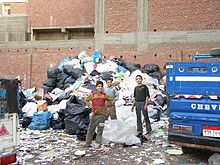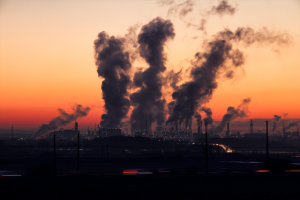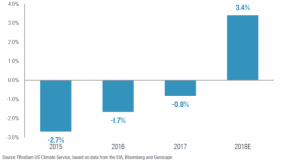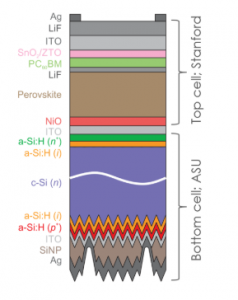January 2019 – Volume 21, Issue 1
In This Issue
Flanigan’s EcoLogic: Hitting Recycling Hard
Solar Panels Produce Drinking Water from Moisture
Learning From the Best Recycling Programs
EcoMotion’s Three-Step Eco-Action Guide on Recycling
Renewables Eclipse Coal in Germany
Patagonia Redirecting Tax Savings to Climate Protection
The World Bank’s Last Coal Project
U.S. CO2 Emissions on the Rise
Green New Deal
Tandem Solar Cell Efficiency Hits 25%

Flanigan’s EcoLogic: Hitting Recycling Hard
Well, the last EcoNet was certainly a blatant diversion from EcoMotion’s commitment to report only good news. “The Recycling Mess” is s hardly good news. Given the reader response on this one, I hit a nerve. It wasn’t a wake-up call because we all know it. The report serves instead of a confirmation that overall, recycling is really broke. Its solutions must be systemic… from ethics to policies, from regulation to universal practice. Along the way… the drumbeat of awareness and the cheers of success.
So how do we take action? In this issue I present a three-step guide for eco-action on recycling. We start local, working in our homes and communities with our existing programs… and making sure we execute them well. Do you know exactly what goes in your bin? If not, find out.
Yes, recycling is confusing and in some ways is devolving: Since writing the issue, I’ve received two recycling program flyers, one from my home town in California, the other from my mom in Oyster Bay, New York where I grew up. They’re totally different. Rick would say, “that sucks.”
Glendale’s program is rather limited, for instance only taking two kinds of plastic (1, 2). Worse, the Town of Oyster Bay program no longer takes glass. Trash the glass instructs the flyer. A nicely produced and upbeat video by the Town says that “due to import restrictions… what can and can’t be recycled has changed.”
What, no glass? After years of educating the public to pull out cans and bottles, to ditch glass seems like a travesty. Doesn’t it? Sure, consumers can still redeem some beverage bottles for deposits, but telling the citizenry to pitch the rest? This seems like a huge step back… reprogramming slovenly behavior of a first world country. We’ve got to change this.
Let’s step back. What’s the goal? Smart waste management a provides multiple benefits: It addresses limits on landfill spaces. It cuts methane emissions from the anaerobic digestion of organic materials. It provides re-use of natural resources from bauxite to glass to paper… and thus less mining and tree cutting. It pulls value from the waste stream… rendering products from wastes. It builds upon a conservation ethic that is sweeping the energy space, transportation, forest management, and food. Smart waste management is a highly visible element of the path to sustainability.
This issue features recycling solutions. There are certainly examples of successful recycling, programs at the country, city, corporate, and campus level. We report on a new national initiative called SWEEP to rate communities’ recycling programs just as buildings have been LEED certified. We present EcoMotion’s Three-Step Guide Eco- Action on Recycling. Yes, all agree that recycling in America is a mess. Now it’s up to us to fix it and when life gives you lemons… to make lemonade.
Quote of the Week
“Organic-inorganic halide perovskites are promising semiconductors to mate with silicon in tandem photovoltaic cells due to their solution processability and tunable complementary bandgaps.”
Summary of scientific paper on the record-breaking tandem solar cell efficiency as presented by Joule
Solar Panels Produce Drinking Water from Moisture
 Zero Mass Water is the company. Advanced water capture is the mission, an ideal solution in poverty-stricken areas like Morocco, Egypt, and India where residents lack access to clean drinking water. For a cost of $2,000, plus installation, each “Source” panel delivers 2 – 5 liters of water daily. Both Bill Gates and Jeff Bezos have invested in the company.
Zero Mass Water is the company. Advanced water capture is the mission, an ideal solution in poverty-stricken areas like Morocco, Egypt, and India where residents lack access to clean drinking water. For a cost of $2,000, plus installation, each “Source” panel delivers 2 – 5 liters of water daily. Both Bill Gates and Jeff Bezos have invested in the company.
Zero Mass Water was launched in 2015 with a remarkable technology. Its Hydropanel makes drinking water from sunlight and air. Far beyond testing, Zero Mass Water has done installations in 15 countries. Its installations are providing drinking water from Lebanon to California, to schools in Detroit and Baltimore… pulling water vapor out of water even in the desert.
![]()
For developed countries, Zero Mass Water claims that the pure water that it produces is “cheaper in the long haul than buying bottled water,” and higher quality than bottled water, filtered water, and water from municipal systems. Every Source array is connected to Zero Mass Water’s global network which tracks production. A new sensor has been added for system owners to allow them to monitor water quality through an app.
The panels use solar energy to raise the dew point, driving passive condensation and the production of high-quality water without a standard power connection. EcoMotion’s Staff Engineer, Brady Zaitoon, speculates that this is done by using the solar power to cool air within the panels. The system’s resulting pure water is as distilled and meets and exceeds FDA and EPA drinking water standards for purity. It is reinforced with calcium and magnesium. The system has a built-in air filter; each panel weighs 340 pounds dry.
Learning From the Best Recycling Programs
Americans produce over 200 million tons of trash annually according to U.S. EPA. Of that 75% is recyclable, though U.S. recycling programs account for a diversion rate of 34%. Meanwhile, a number of countries have nearly doubled this. Planet Aid reports that Austria has long topped the charts with a 64% diversion rate. Germany is not far behind at 62%, followed by Taiwan at 60%, and Singapore at 59%.

Austria
An analysis of Austria’s success was written in 2013 by its Minister of the Environment, Nikolaus Berlakovich, shortly after the European Commission cited the country for its 69.8% recycling rate. He reported that ecycling began in earnest in the 1990s with careful analysis of the waste stream. Austria’s use of accurate information “constituted a pre-requisite for optimized waste management planning….” The country then got serious about the regulation of waste streams – and prescribed requirements for their specific end-of-life treatments. Landfill bans were imposed on certain waste types. The country instigated significant “remediation contributions,” what we call “tipping fees,” at landfills and at incinerators. Comprehensive information campaigns have been crucial for success though-out, as have all manner of re-use initiatives and waste prevention programs.

A Group of Boys at Moqattam Village, dubbed “Trash Town”
The literature on recycling includes an amazing story. The impoverished Zabbaleen people live in “Trash Town” on the outskirts of Cairo, Egypt. They run what some call “the world’s most effective recycling program.” They are literally the “garbage people,” going door-to-door collecting garbage in the capitol city. They gather, transport, and sort and recycle as much as 80% of the trash… demonstrating the best diversion rate in the world. Their town is a dump. They live off it, from salvaged kids toys to food for pigs that are part of their livelihood. While not desirable to scale — we certainly seek more elegant and equitable solutions — the Zabbaleen prove possible the recovery of the vast majority of waste streams.
Some cities are taking exemplary action. While New York City has a recycling rate of 21% (Chicago 10%), San Francisco boasts an 80% diversion rate, with mandatory residential recycling and composting, banning things like plastic bags and Styrofoam. All organics are processed in Vacaville into valuable soil amendments. Corporations such as Best Buy have been too. Best Buy has been voluntarily running the nation’s most comprehensive e-waste program since 2009… recycling customers’ ink cartridges, batteries, computers at no charge. Campuses are hotbeds of recycling activity… spurred on by “RecycleMania” a competition now involving hundreds of colleges and universities across the country, that started as a competition in 2001 building on a football rivalry between two Florida universities. Since then 3,000 colleges have participated. Heralded universities include the College of the Atlantic, Warren Wilson, Evergreen State, American University, Valencia College, University of California at Davis, Pepperdine University, and Harvard.
Harvard University has been a national recycling leader for some time. Harvard has shown that with adequate commitment and investment, high rates can be achieved and sustained. Harvard uses single stream and has broken records doing so. Its program is comprehensive, single stream and inclusive of dozens of materials including plastics 1 – 7, juice boxes, and empty aerosol cans. Launched in 2009 to eliminate any guess work or confusion, Harvard believes that ease and convenience of single stream increases the amount diverted. The University also runs highly exemplary surplus office and computer equipment re-use and freecycling programs, while covering football game tailgating!
But why not regulate what goes into the trash? Global Citizen reports on countries and cities have banned single-use plastics, from microbeads in cosmetics, to straws, bags, and bottles. Kenya is home to the world’s harshest plastic bag ban. The United Kingdom plans to set the gold standard for eliminating plastic waste. Zimbabwe has a national ban on polystyrene food containers. Montreal and many others ban plastic bags; Malibu which has eliminated plastic straws and stirrers and cutlery. Other similar programs are in effect in Australia, Canada, France, Morocco, and Rwanda.

Rob Watson
A new and encouraging initiative called SWEEP is being promoted by Rob Watson, Chief Science Officer for EcoHub, a “disruptive company that aims to revolutionize global material management by separating, diverting, and recycling up to 95% of municipal mixed waste that is collected in one bin. Rob was the founder of LEED in 1993 and developed the now ubiquitous building certification system for 12 years. LEED can be credited for jumpstarting sustainability in the architecture and construction communities. Watson’s intent for SWEEP is to mirror LEED. Why not rate community solid waste management practices and recycling programs just as we rate buildings using LEED or campuses using STARS?
Just as LEED provided an end-game for green buildings, the Solid Waste Environmental Excellence Protocol (SWEEP) Municipal Standard is intended to create a roadmap and a template of best practices. The SWEEP rating system is based on six categories: Sustainable Material Management Policy, Waste Generation and Prevention, Solid Waste Collection, Post-Collection Recovery, and Post-Collection Disposal and Innovation. SWEEP is currently seeking experts to participate in its planning process and is accepting comments on the rating system through the end of this month. Once the rating system is finalized, municipalities will apply for SWEEP certification.
EcoMotion’s Three-Step Eco-Action Guide on Recycling

1. Be Exemplary
- Understand your local program – add signage near your bin!
- Adhere to your local program guidelines… be an exemplary recycler!
- Discuss your local program with neighbors… the ripple effect
2. Minimize Your Waste
- Buy less, buck consumerism when possible.
- Carry your own bags for all shopping.
- Cook and eat fresh food. Shop at farmers markets with your own containers.
- Place “Eat-Me-First” container front and center in your fridge to minimize spoils.
- Buy and maintain durable products… things that last.
- Buy products with re-usable or single-material packaging, in bulk when possible.
3. Speak Out
- Make your voice known to vendors about their packaging
- Make your voice heard at your local markets
- Speak out at City hall and other government venues
- Join associations, attend conferences
- Promote candidates that value this movement
Renewables Eclipse Coal in Germany
 Renewables have now surpassed coal-fired electricity production in Germany, overtaking the use of domestic brown coal and imported hard coal. Renewables are providing 38% of the country’s power supply… up 2% from 2017. The German renewable portfolio includes onshore wind (16%), offshore wind (3%), biomass (8%), photovoltaics (8%), hydroelectricity (3%), and geothermal (1%). Renewables in 2018 provided 229 billion kWh, 38% of Germany’s total annual load of 599 billion kWh. The country’s goal for renewables is to fulfill 65% of electricity demand by 2030.
Renewables have now surpassed coal-fired electricity production in Germany, overtaking the use of domestic brown coal and imported hard coal. Renewables are providing 38% of the country’s power supply… up 2% from 2017. The German renewable portfolio includes onshore wind (16%), offshore wind (3%), biomass (8%), photovoltaics (8%), hydroelectricity (3%), and geothermal (1%). Renewables in 2018 provided 229 billion kWh, 38% of Germany’s total annual load of 599 billion kWh. The country’s goal for renewables is to fulfill 65% of electricity demand by 2030.Patagonia Redirecting Tax Savings to Climate Protection
“We’re giving our $10 million tax cut back to the planet,” stated Patagonia’s Chief Operating Officer, Rose Marcario. And that’s on top of the company’s longstanding 1% for the Planet commitment. Since 1985 Patagonia has given over $100 million to support sustainability-oriented nonprofits.
CEO Rose Marcario has announced that Patagonia will give away the millions that the company will save in 2018 given the tax reform that lowered the corporate tax rate from 35% to 21%. Marcario called the tax cut, intended to boost the economy and thus lower the national debt, which it hasn’t, “irresponsible” in light of the findings of the Fourth National Climate Assessment released in November 2018. In response, Patagonia will give $10 million to grassroots organizations fighting climate change.
Marcario said the 1,656-page Assessment “painted a future in stark terms,” marked by a potential 10% loss to the U.S. economy due to mega-fires, toxic algae blooms, heat waves, hurricanes, and more. The Assessment was prepared by 13 U.S. agencies and more than 300 researchers and concluded that the Earth could experience 3-9 degrees F warming by 2100 potentially setting off a slew of devasting effects. While the White House debunked the report, the Patagonia CEO cited hundreds of billions of dollars of losses and stated that “denial is just evil.”
The World Bank’s Last Coal Project
 The World Bank has discontinued its loan guarantee for what is dubbed its last coal project. The Bank claims that since a coal plant planned for Kosovo for which it had offered loan guarantee, can no longer be justified since coal is not the lowest-cost option. The Bank finds that the costs of renewable energy sources come in below the cost of the lignite coal plant. While the Kosovan government still backs the plant and its developer is seeking alternative finance sources, the rescission clearly shows the World Bank’s pivot to clean energy. In 2013, the bank revised its lending policies to rule out coal projects, except in exceptional circumstances, ending support for coal worldwide. The 500 MW Kosovo plant has been the only project for which the bank has been considering support. And now the bank has made what it calls “a very firm decision” not to go forward. Furthermore, the Bank’s International Finance Corporation, which works with 2,000 clients across 125 countries, is taking it a step further and is seeking more transparency on and developing exit strategies for its remaining coal projects.
The World Bank has discontinued its loan guarantee for what is dubbed its last coal project. The Bank claims that since a coal plant planned for Kosovo for which it had offered loan guarantee, can no longer be justified since coal is not the lowest-cost option. The Bank finds that the costs of renewable energy sources come in below the cost of the lignite coal plant. While the Kosovan government still backs the plant and its developer is seeking alternative finance sources, the rescission clearly shows the World Bank’s pivot to clean energy. In 2013, the bank revised its lending policies to rule out coal projects, except in exceptional circumstances, ending support for coal worldwide. The 500 MW Kosovo plant has been the only project for which the bank has been considering support. And now the bank has made what it calls “a very firm decision” not to go forward. Furthermore, the Bank’s International Finance Corporation, which works with 2,000 clients across 125 countries, is taking it a step further and is seeking more transparency on and developing exit strategies for its remaining coal projects.
U.S. CO2 Emissions on the Rise

Annual change in U.S. CO2 emissions
The Rhodium Group, an independent research provider headquartered in New Yok City, reports that the overall 2018 U.S. greenhouse gas emissions increase including power, transportation, industrial, and buildings was 3.4%. Troubling is that following three straight years of decline, U.S. power sector greenhouse gas emissions rose in 2018. Power sector emissions – specifically CO2 — increased 1.9% in 2018, flagging at least the short-term aberration as the head-long surge to beneficial electrification – with the power sector taking the lead in establishing a decarbonized society — and the greening of the power sector are not perfectly aligned. In 2018, economic growth and the rise of natural gas use in the power sector have outstripped the emissions reductions experienced by the phase-out of coal and concurrent rise of renewables.
For years, greenhouse gases in the power sector have dropped largely due to economic forces. There has been decreased power demand due to recession. Power sector emissions have been reduced by more than 12% between 2007 and 2015. Then 2018… a change of course: While 14,000 MW of coal-fired capacity was retired in 2018, natural gas use in the power sector was used to generate an additional 166 million kWh during first ten months of 2018, three times the decline in coal use and four times the combined growth of wind and solar.
In terms of CO2, we’re trending in the wrong direction. The International Panel on Climate Change (IPCC) warned in October that humans have little more than a decade to virtually eliminate GHG to stand a good chance of averting the worst impacts of climate change. Even before President Trump announced his decision to back out of the Paris Agreement, the U.S. was already behind to meets its targets of a 26 – 28% emissions reduction by 2025. Researchers now estimate that the U.S. will have to reduce power sector emissions by 3 – 3.3% per year… faster than the average rate of 1.2% from 2007 – 2015. (Germany is experiencing the same issue.)
Now another major development: Global warming has raised average global temperatures by about 1 degree F over the past century, while the change has been only 0.18 degree F for ocean temperatures. But new research reveals that ocean temperatures are rising faster than predicted, heating up 40% faster than a United Nations panel estimated five years ago. Since the mid-2000s, the Argo project which is part of an integrated global observation strategy, has deployed a fleet of 3,921 floating robots now drifting in the oceans approximately 300 kilometers apart around the world. Every few days as programmed, they dive to a dept of 2,000 meters to measure oceans temperatures, salinity, and other indicators.
Ocean subsurface temperatures are important markers of climate change as fully 93% of excess solar energy trapped by greenhouse gases is absorbed in oceans. Unlike surface temperatures, ocean temperatures are not affected by year-to-year variations. The robots measure where most marine life thrives, including areas most vulnerable to climate change such as coral reefs. Other species are vulnerable, such as krill at the base of the food chain. And as ocean water heats up, it expands, causing sea level rise. That in turn leads to coastal inundation and shoreline erosion. Hotter waters also lead to more power full storms.
Green New Deal

Thomas Friedman
In 2007, journalist Thomas Friedman coined the term Green New Deal for a new economic order. Just as Franklin D Roosevelt’s New Deal pulled our country out of a pickle-the Great Depression – the Green New Deal will too. It calls for a new economy based on massive investments in the future… creating new industries, fueling new jobs, and a new-found prosperity.
The Green New Deal Group advanced the concept in 2008. Then UNEP began to promote is… that a global green new deal would create jobs in green industries, boosting the world economy, and curbing climate change at the same time. Barack Obama used the term in his 2008 campaign, but as Friedman said in a recent New York Times OpEd, “… the idea just never took off.”
The Green New Deal has its conceptual roots in the New Deal. The New Deal was a series of programs and public works projects, financial reforms and regulations, that were instituted during the Great Depression (1933 – 1936) by President Franklin D. Roosevelt that aimed to restore prosperity to Americans. And it did. Giving great hope, visible manifestations of getting back to work, and fuel to the economic recovery.
Recently Friedman’s concept of the Green New Deal is getting new life: Congresswoman Alexandria Ocasio-Cortez (D-NY) and others (the Sunrise Movement – “an army of young people to stop climate change and to create millions of good jobs in the process”) have put forth their notion of a Green New Deal, and “it’s getting some real attention.” Ocasio-Cortez calls for 100% renewable energy in 12 years, a living-wage, job guarantee program for anyone who wants one, universal health care, and more financed in part by higher taxes on the wealthy.
Regardless of its definition, and Friedman is pleased that the term has come to light. He welcomes suggestions to define the scope of the deal, Friedman states that, “… this is a massive undertaking required a massive, urgent response commensurate with the scale and time frame posed by accelerating disruptive climate change.” He stresses that green cannot be boutique. Its got to be the new red, white and blue. Solar can’t be a hobby. Carbon-free sustainability needs to scale. The Green New Deal is a strategy for American national security, national resilience, national security and economic leadership in the 21st century. Friedman amplifies the urgency: “Forget the space race. We don’t need a man, or woman, on Mars. We need an Earth Race….”
Tandem Solar Cell Efficiency Hits 25%

Bush_ K. A. et al. 23.6_-efficient monolithic perovskite_silicon tandem solar cells with improved stability. Nat. Energy 2_ 17009 _2017_.
Photovoltaic efficiency barriers have been broken time and time again. Solar cell efficiency refers to the portion of energy in the form of photons of sunlight that can be converted via photovoltaics into electrons and electricity. Put another way, a cell’s efficiency is the ratio of the cell’s output to the input energy from the sun. In 2014 researchers hit the highest efficiency ever by fabricating a multi-junction, concentrating photovoltaic system that achieved an efficiency of 46%. Since then another record was set for multi-junction cells, 40.7%, by Spectrolab, a subsidiary of Boeing. These cells are made of layers that capture full spectra of light. Cells like these may be made of exotic materials such as gallium arsenide or indium selenide and might cost 50 – 100 times that of photovoltaic panels in mass production.
Commercially available solar panels are typically in the 15 – 17% efficiency range. Here are some top efficiency leaders known for their efficient panels: SunPower 21.5%, LG 21.1%, Solartech Universal 20.2%, Silfab 20.0%, Solaria 19.4%, Panasonic 19.7%, Sunpreme 19.5%.
Another solar cell innovation being funded by the U.S. Department of Energy’s Solar Energy Technology Office (SETO) is silicon-based, tandem solar cells. Last year researchers at Arizona State University achieved an efficiency of 23.6% in a tandem solar cell stacked with perovskite and silicon. Now they’ve been able to beat their own record, boosting the tandem cell’s efficiency up to 25.4%, a two-point gain. In a joint project with researchers from the University of Nebraska, these solar pioneers are predicting they’ll be nearing 40% tandem cell efficiency in two years. The U.S. DOE’s SunShot Challenge is funding numerous research initiatives such as this on to drive down the costs of solar to $0.03 cents per kilowatt-hour resulting in a boom and a 17% power generation market share by 2030.
